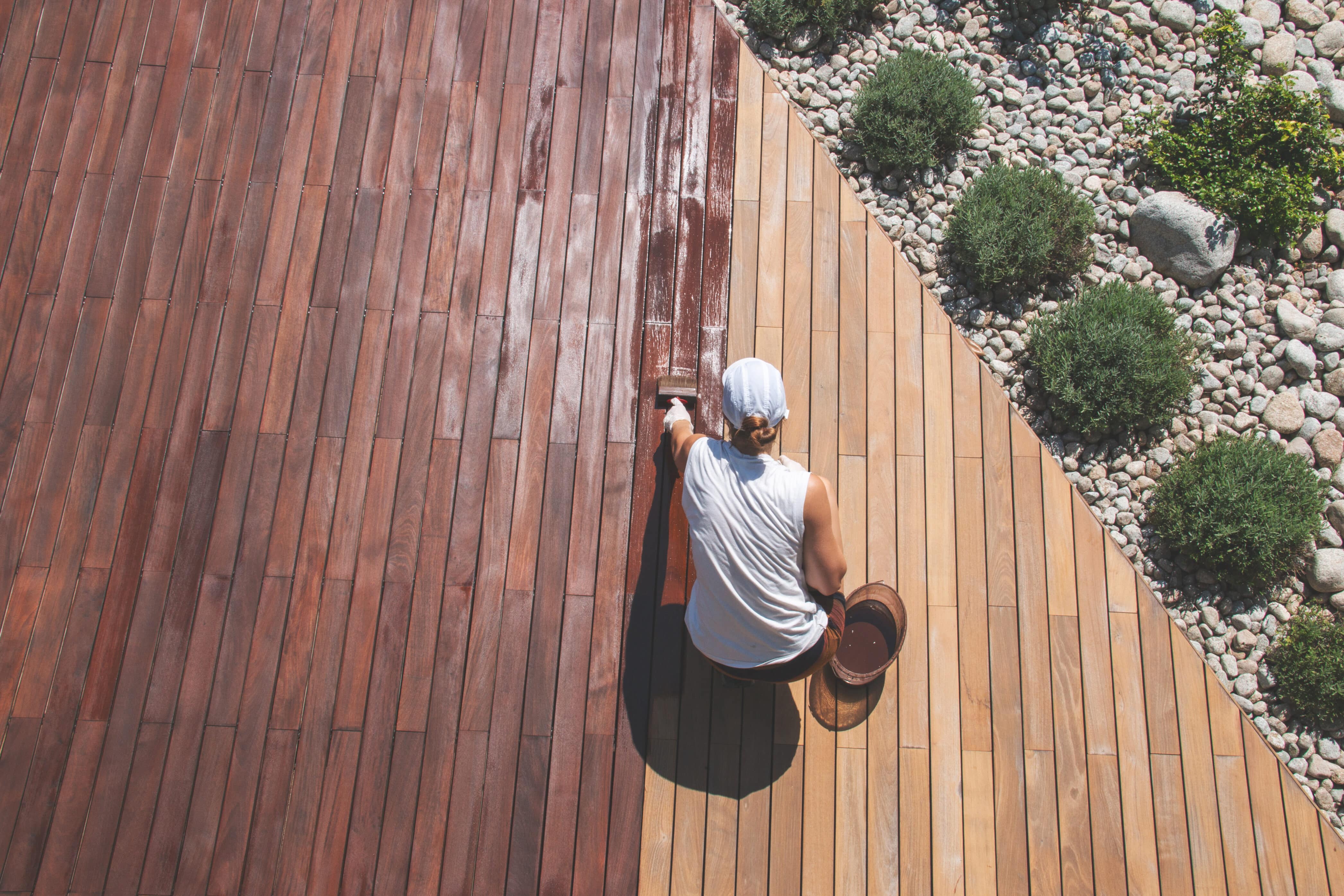
How to Stain Your Deck
Staining your deck can improve the appearance of your home and extend the life of your deck. However, at an average cost of $700, it can be an expensive proposition. If you don’t want to pay a professional to do the job, learning how to stain the deck yourself could save you some money.
How To Prepare Your Deck for Staining
The main cause of cracking, bubbling, and other issues with the appearance of a newly-stained deck is improper preparation. Take these steps before you start staining your deck.
Take Safety Precautions
If your deck is made from older, pressure-treated wood, sanding and pressure-washing it could release toxins. Consider hiring a licensed contractor who will have the appropriate safety gear and training to complete the job.
If you do the job yourself, wear safety glasses, a respirator, and nitrile gloves. Avoid disposing of oil-soaked rags or paint rollers in the trash, where they may spontaneously combust. Soak them in water and allow them to dry before throwing them out.
Clean Your Deck
Start by removing all furniture and other items from the surface of your deck. Sweep the deck to remove excess dirt and debris.
Apply a wood cleaner to the deck, and let it sit for about 15 minutes. Use a scrub brush to work the cleaner into the deck, and scrub thoroughly to remove residue.
Rinse the cleaner from the deck using a hose or a pressure washer. But be careful—use a lower setting to avoid marring the finish! Allow the deck to dry completely.
Remove Stains
If your deck has marks or discoloration after you have cleaned it, you must remove them before you stain the deck. Sand off any discolored or stained spots. Use wood-cleaning supplies to eliminate graying caused by mildew, sunshine, and older stains.
Inspect Your Deck
Inspect the deck for warped wood, broken screws, and other problems. Repair any issues before you stain the deck. If your deck has loose wood fibers or splinters, sand the wood to remove them.
Choose the Best Stain for Your Deck
Apply a small amount of deck stripper in an inconspicuous area to determine what type of stain is on your deck. Let the deck stripper sit for 15 minutes, and then wipe it off with a rag. If the stripper removes the stain, then the stain is water-based. If not, it is oil-based.
Use a deck stripper to remove water-based stains before re-staining the deck. If the stain is oil-based, you can recoat it with an oil-based stain after cleaning the deck. Do not put a water-based finish over an oil-based finish.
Choose Your Tools
Read the instructions on the product label for the stain you chose. The manufacturer may direct you to use a brush, paint sprayer, or nap roller.
If you use a brush, use one made from synthetic materials. A wider brush will allow you to cover a larger area in less time and will provide more uniform coverage and finish.
If you are using a paint roller or sprayer, it’s essential to have a brush on hand for precise work in corners and challenging-to-reach spots. Additionally, for areas like railings or gaps where boards meet, you might find a staining sponge particularly helpful, as it offers added control.
Sprayers are the fastest tool but require more experience to achieve the best results. Gather hand rags for cleanup and tape or plastic to protect surfaces around your deck.
When To Stain Your Deck
You should stain your deck about once every three to five years. Check the weather before beginning your project. Ideally, you should stain your deck after several days of dry weather when the temperature is between 50 and 90 degrees Fahrenheit.
Choose a day with low humidity to achieve the best quality. Avoid staining your deck when the forecast calls for rain within the next 12 to 24 hours. Aim to have at least two dry days after you stain your deck to allow the stain to set and dry properly.
Can You Stain a Deck in the Sun?
Direct exposure to sunlight can cause your stain to dry too quickly, which can result in a blotchy look. Slower drying permits the stain to penetrate the wood and keep it thoroughly protected. Stains that dry improperly may fail early. Stain your deck at a time when there is no sunlight shining directly on it.
How To Stain a Wood Deck
Stir your stain thoroughly, and then pour it into a paint tray. Test a small area to ensure you like the color and appearance before you start staining the deck.
Stain the posts, railings, and balusters with a handheld paint pad or brush, using long, even strokes. Stain the outer and inner sides of the deck stair handrails.
Identify how you plan to exit the deck, and then begin staining the boards in the direction of the exit. Apply a single coat of stain using long, even strokes.
Use a paintbrush to fill in any cracks or other areas you missed. Clean your brushes and paint tray.
Allow your stain to dry for a minimum of 24 hours. Optionally, apply a coat of sealant to extend the life of your stain.
I Stained My Deck and It Is Blotchy
Softwoods, such as pine, may absorb stains unevenly, causing blotches. Improper applications can also cause this problem.
Applying a second coat of stain may even out the blotchy appearance. Be sure to apply the stain in long, even strokes, and wipe off any excess stain before it dries. If this doesn’t work, you may have to strip off the stain and start again, taking care to follow all the directions in this guide.
Where To Get Help with Deck Staining
Have problems with your deck staining project? Decks & Docks can help.
Decks & Docks is your one-stop shop for all your decking, marine, seawall, and piling needs, serving the entire East Coast of the U.S., from the Florida Keys all the way up to NY. Whether you want to learn how to stain a deck or get help rebuilding a damaged deck, the experts at Decks & Docks can assist you.
Contact us today to find out more.
- About the Author
- Latest Posts
Dan has worked for Decks and Docks for over twenty-five years. He managed the original Decks and Docks store in St. Pete, which is our largest store. Dan is simply the best all around. He knows more about this company and our products than probably anyone else. Dan currently works in Sales at our corporate office.
